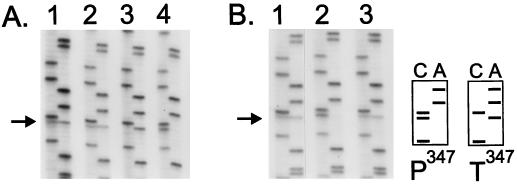FIG. 3.
Relative fitness of wild-type B. subtilis cells expressing either the wild-type P347 or the mutant T347 variant of Bmr. The cells were mixed at a 1:1 ratio and then cocultivated in different media for approximately 100 generations. DNA, isolated from the original mixture of cells or from the cells which underwent cocultivation, was used as a template to amplify the bmr gene by PCR. Shown are the sequences of the resulting PCR products (in each lane pair, cytosine at left and adenine at right). The position of the nucleotide that is different in the two strains is indicated by an arrow. As shown schematically, cytosine at this position corresponds to the wild-type sequence (triplet CCT encoding proline), whereas adenine at this position corresponds to the mutated sequence (triplet ACT encoding threonine). Results of two independent experiments are shown in panels A and B. (A) Lane 1, original mixture; lane 2, cocultivation in a nutrient-rich medium (1% tryptone, 1% NaCl); lane 3, cocultivation in the same rich medium containing the toxic Bmr substrate ethidium bromide (0.2 μg/ml); lane 4, cocultivation in a poor medium (0.1% tryptone, 1% NaCl). (B) Lane 1, original mixture; lane 2, cocultivation in a poor medium (0.1% tryptone, 1% NaCl); lane 3, cocultivation in the same poor medium containing reserpine (5 μg/ml).

